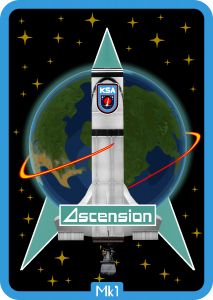 After a series of launch pad abort tests, our original space capsule was pretty beaten up and no longer able to fly into space. However it could still handle being launched through the atmosphere so we gave it the final task of performing an ascent abort test last week to fully qualify the Launch Escape System for kerbed flight. While it could be considered wasteful to essentially toss away a complete rocket in the process, we strive to achieve the utmost safety for our crew whatever the cost.
After a series of launch pad abort tests, our original space capsule was pretty beaten up and no longer able to fly into space. However it could still handle being launched through the atmosphere so we gave it the final task of performing an ascent abort test last week to fully qualify the Launch Escape System for kerbed flight. While it could be considered wasteful to essentially toss away a complete rocket in the process, we strive to achieve the utmost safety for our crew whatever the cost.
The Flight
Launch occurred on time without delays, mainly due to the fact that we didn’t much care what the weather would be like since we knew the abort was going to happen regardless and any adverse conditions would only give us additional data. The rocket did not have its elevator fins adjusted so it could be launched sooner but it did not require full pitch control to head downrange during ascent.
A nominal climb through the lower atmosphere with the K2-X engine putting out full thrust saw the rocket reach the upper atmosphere (18km) at L+1m6s and 1 second later the LES was activated. The capsule made a clean separation from the rocket (which remained under power as planned, the engine did not cut off) with the LES motors burning out after 3 seconds of pushing it clear of the rocket’s path and the tower detaching immediately afterwards.
The capsule continued to fly up to an apokee of 36km at L+2m9s before starting to plummet back towards the surface. The parachutes had already been armed and deployed as the capsule passed through 30km at L+2m49s. They stayed reefed, adding extra drag to slow the capsule further as it descended through the lower atmosphere and fully deployed to arrest the descent at L+5m12s at around 600m. The capsule dumped the (dummy) heat shield and splashed down safely at the north end of the bay at L+7m05s, 32km from KSC.
Flight Analysis
While the capsule made a clean separation and successful splashdown for recovery the real test was whether the crew member aboard would have survived the experience. We’re happy to say that the answer is a resounding yes. During the abort sequence the astronaut would have experienced upwards of 6G peak force, which is easily survivable. The capsule was flown well clear of the rocket, as can be seen in this ground tracking video, and the wash of rocket exhaust had no effect on it.
We chose this point to initiate the LES as the most extreme case given the rocket was traveling at supersonic speeds with a decent amount of atmosphere still present. The data shows we have a reliable escape system for our crew in the event that anything should go wrong during a launch.
Future Plans
While the primary purpose of the LES is to protect the crew in the event of a launch disaster, we still want to look into possibilities for use of the LES after launch. Unless mission requirements are extremely tight, carrying the LES tower along for the entire mission won’t be much of a detriment and could serve useful in other scenarios: if the capsule needs an abrupt return, the LES could be used to pull it out of orbit or onto a steeper descent trajectory; if descent is too steep for some reason the LES could be used to slow the initial re-entry; if something happens to the parachutes and they fail to arm or respond to commands the LES could be used as a last-ditch option to slow the capsule before impact.
The next (and perhaps final) uncrewed mission will leave the LES attached and fire the motors during descent to ascertain how well they would arrest the capsule.







